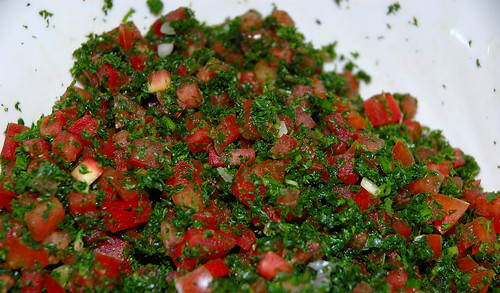لابانيسي يلة مع الاصدقاء والمطبخ
I can't wait. The holiday, or at least the mood of it, has been set in motion a week earlier. When Natty called me, I knew it was going to be another gorgeous home-dining experience. And I knew my cookware and everything else would have to give way to the challenge.
One thing I did't expect though. It wasn't the usual Thai dinner, which Natty Orranut Hiranmathakij is instinctively good at. It was, to my surprises, a gorgeous Arabian experience. (Natty is a beautiful friend of mine who, I still speculate, must have been Miss Thailand two decades ago.)

Natty's boyfriend Sam is an Australian living/working in Hong Kong for many years (arguably also, the most goodlooking pilot in this part of the world). He has an Lebanese ethnic origin. This holiday he had his family visiting. And I had the privilege to try out some of the best Lebanese family cookings.
This time Sam's sister, Mirna, took over the kitchen. The hard work began in the morning. Correct me if I'm wrong, Labanese food is closely associated with the Meditteranean. The parsley, the mint, the olive oil, the yogurt, the lamb, etc, etc. It was a huge task for her since the true ingredients are rarely available in Hong Kong.
When I got there, the eloquent Sam already started telling me stories of Lebanon. There were some that I'd heard and some that I hadn't. Anyway.
The area including modern Lebanon has been for thousands of years a melting pot of various civilizations and cultures. Originally home to the Phoenicians, and then subsequently conquered and occupied by the Assyrians, the Persians, the Greeks, the Romans, the Arabs, the Ottoman Turks and most recently the French, Lebanese culture has over the millennia evolved by borrowing from all of these groups.
The country has enjoyed only brief periods of relative calm. The Israeli's attack during the summer last year. The 15-year civil war that began in 1975, devastating the country massively. The Arab-Israeli war in 1948. In short, it's a country that has a lot of complexities and sensitivities, politically, ethnically and religiously. (That's all an unqualified historian can tell.)
Some of the most popular Lebanese dishes include Kibbeh—a lamb-and-cracked-wheat dish, often grilled or fried—and Tabbouleh, a salad made with cracked wheat, finely chopped parsley, tomato, onions and olive oil. This time, Mirna was making a couple of popular dishes. I have forgotten most of the names. But I remember I did have Tabbouleh (2nd pic of this post). We ate it with bread and fresh yogurt. Simple but absolutely beautiful. Besides the yogurt, Mirna prepared a special dipping made with beans which I cannot name (3rd pic). Those dippings already made my day!
It wasn't a complete Lebanese dinner really. Natty made the chicken satay and some very nice Thai fried-rice with roast chestnuts. We were drinking Aussie and Kiwi wines, especially my favourite Marlborough Sauvignon Blanc. They all went perfectly well together. They were all mouth-wateringly beautiful!
Copyright © 2006-2009 Minimalist Cooking

7 Comments:
wonderful dishes!
Thanks Eliza! I have linked you if you don't mind. Let me check what you're cooking lately also...
Go back to study, 姐姐!
Just curious, how many times would you edit each of your posts on average? :P
0-100, i guess. Just curious, do you copy/memorise each of my posts? You're such a fan, jeh jeh!
係呀!我當唐詩咁背o架..不會吟時也會偷嘛!
姐姐, 除左O咀之外, 都唔知比乜反應妳囉 :O
Post a Comment
<< Home